The Walking Rebellion: Restoring the Mind at Three Miles an Hour
How to boycott the Machine in 10,000 easy steps
For those of you who prefer to read off paper rather than the screen, we have converted the post into an easily printable pdf file.
and I walked a combined 100 km while thinking and talking about “The Walking Rebellion”. Over the last two decades we walked an estimated 20,000 km. Just yesterday I walked for two hours to the local university and back, a busy four-lane road with cars zipping by to my right, sparrows peeping in the bushes to my left.We could have chosen to write this essay by referencing the well-known insights from famous walkers such as Rousseau, Kirkegaard, Nietzsche, or Solnit, but we have noticed that the more we have walked, the more their insights sprang naturally out of the act of walking itself1.
Because we walk so habitually, it is easy to take for granted, and to forget that walking is a central part of what restores our minds at so many levels.
discusses “eight pillars of connection” including connecting with nature, people, history and tradition, and spiritual or higher values, that are all under “simultaneous attack” in our current culture. But it is hard to counter that attack. , who recently graded his students’ reflections on going screen free for a day, points out that,Young adults aren't in denial about their devices’ adverse effects. But screens are so addictive and so pervasive, and they've been part of twentysomethings’ lives for so long, that many people that age don't think a low-screen-exposure existence is a realistic hope.
And it is not just young people. We have all been affected to a greater or lesser extent by the hijacking of our attention, the digital replacement of reality2, and the omnipresence of digital tech in our daily activities. Yet there are various ways of addressing these challenges, which we have written about here, here, and here. Today we add one more: walking.
Walking is one of the simplest and most universal actions imaginable for human beings, and one of the ultimate acts of unmachining.
Walking redirects our muddled thoughts outward toward the scenery we are passing. It helps us to connect with each other in shared conversation and rhythmic pace. It echoes history and tradition through a most simple movement that has remained “essentially unimproved since the dawn of time.”3 Importantly, the act of walking not only restores our minds, but helps to build up internal resilience and resistance against algorithmic mental slavery.
observes that Saint Augustine’s phrase “solvitur ambulando” - it is solved by walking - holds a potent truth: “It is the realization that freedom of the mind is intertwined with freedom of movement.”
In today’s piece we’ll explore research of the positive effects of walking on physical and mental health, how walking can improve cognitive patterns, connection to others and our surroundings, and how joining our “tech-naked” Walking Rebellion is a practical first step in restoring the mind.4
I walk in order to stand still. Standing still in awe at new (and familiar) sights, be they birds, mountains, cultures, or traditions.
I walk to be alone with my thoughts, to test out sentences that will one day be formed and crafted into essays. I walk to experience the places, people, creatures, and moments that will become the subjects of my written words.
I walk to write, and I write to walk. -
During the month of the Walking Rebellion (details at end of post), we are happy to offer our readers a 20% discount on paid subscriptions. Thank you for your support!
A Peripatetic Panacea
Is walking a “peripatetic panacea”—a cure-all?
Not quite, but its effects are surprisingly salubrious.
One review of studies suggests that long-distance walking, including even “shorter” walks of one day or up to 12 km, have beneficial effects on stress, depression and anxiety. This benefit might be a result of getting “green exercise”—a combination of exercise and being in nature—or possibly because walking promotes “flow” states and other positive mental changes.
And yet, while long-distance walking reduces emotional distress, the benefits are not necessarily associated with pleasure:
Long-distance walking may be a “journey redolent with meaning”…emphasizing the deeper and perhaps more profound mental benefits provided by the walks, rather than hedonistic well-being. It may thus be hypothesized that, just as therapy is not necessarily pleasurable, the same can be said of long-distance walking.
So, walking long distances might not always feel “good” or “fun”, but it can soothe our emotions and feed the soul.
Another theory suggests that walking promotes spontaneous fluctuations in the mind that are similar to fractals:
A fractal is a pattern that roughly repeats across scales — like a tree whose few big branches have many smaller branches with even more leaves that look like tiny branches. Scientists have found that spontaneous neural activity follows a similar branching pattern throughout the brain, and has a related proportion of a few slow and strong frequencies to more faster and higher frequencies scientists call "pink noise"…
Fractal patterns are easy on the eyes, endlessly fascinating to see and hear and even inspire feelings of beauty. When we take a walk outside, the fractal rhythms of our heart synchronize with the fractal rhythms of our lungs and our fractal gait.
Others have put it this way: “Walking at our own pace creates an unadulterated feedback loop between the rhythm of our bodies and our mental state”5
And in this way walking might help free us from the addictive grip of tech algorithms. Spending too much time behind a screen can make our thoughts “staccato” and disjointed, yet once we start walking, our mind can begin to feel notably smoother, slower, and more alert.
Researchers have also shown that our wandering bodies make our minds wander too. On a walk, our brain waves slow down. The underlying spontaneous fluctuations bubble up more easily, creating experiences of spontaneous thoughts and associations that seem to come from nowhere. We often call them "moments of inspiration."
This well of inspiration that springs from walking is particularly evident in the comments of philosophers and writers. Jean-Jacques Rousseau claimed, “I can only meditate when I am walking. When I stop, I cease to think; my mind only works with my legs.”
In a letter to his friend John Forster, Charles Dickens wrote, “if I couldn’t walk fast and far, I should just explode and perish”, while Henry David Thoreau wrote in his journal, “Methinks that the moment my legs begin to move, my thoughts begin to flow.”
And for those who want to philosophize into old age, regular longer-distance walking has been found to be associated with a reduced risk of cognitive decline and dementia, with a major UK study suggesting optimal benefits at 9800 steps per day.
It can help people live longer too. Walking 8000 steps, even just one or two days a week, has been associated with a reduced risk of death due to cardiovascular and other health risks6.
All this reminds us of an old Greek grandmother we once met. She looked young and hardy, and we asked, “What’s the secret to your health?”
She replied without hesitation: “Keep moving”.
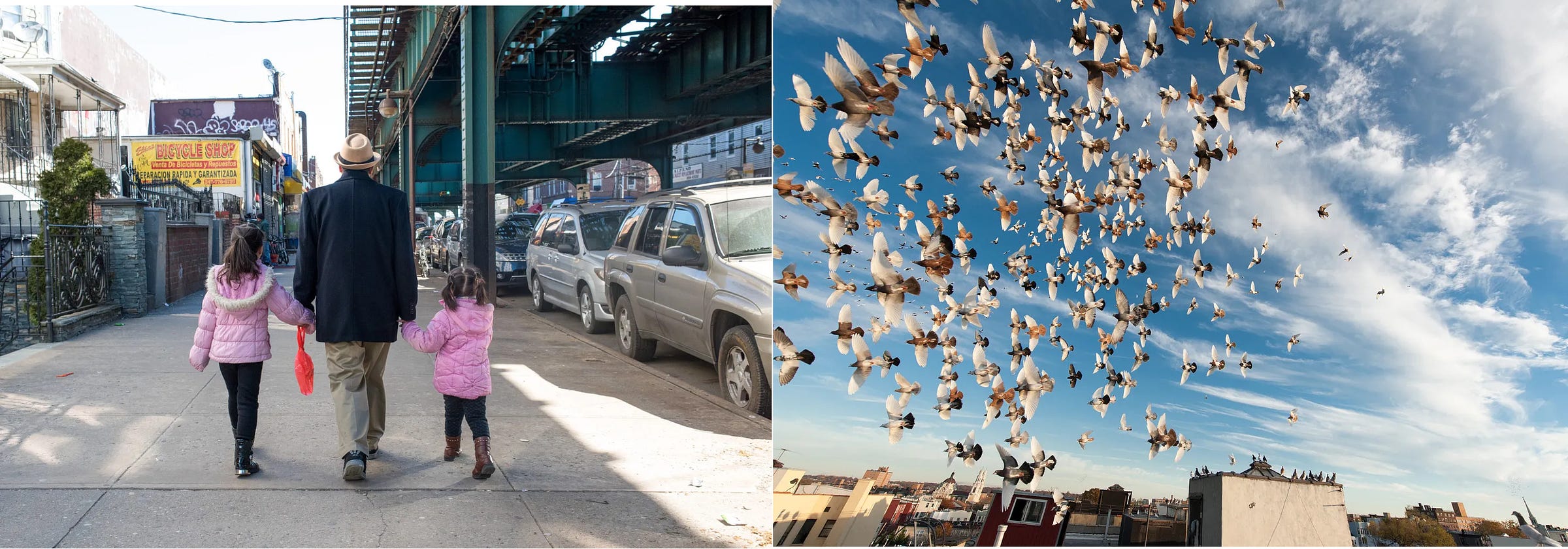
While that is certainly not the most efficient way to see a city, it is the most pleasant, insightful, and human. I don’t think you can know a place unless you walk it, because it isn’t about distance, but about content.
Cars suck for that. They are a brutal way to get to know a place. A literal metal bubble that cuts you off, zooms you through, and then dumps you in another bubble of your choosing. A wall between you and the world.
from Why I Walk by
Connecting to Nature (or City, or Suburb)
It does not matter where you walk. You do not have to live near a nature reserve or an Italian piazza to go for a walk. Our family has walked through some of the most stunning alpine landscapes imaginable; more often we have walked along the sprawl of suburban streets and strip malls.
Yes, walking in nature is preferable as “it is filled with intriguing stimuli, grabs attention in a bottom up fashion, allowing top-down directed-attention abilities a chance to replenish”. Indeed the idea of “biophilia”, our natural tendency to be drawn to nature, proposes that the sights, sounds, and smells of a natural environment benefit our physical and mental health.
Given that 83% of the U.S. population lives in urban settings, nature is not easily accessible to the majority of people. Yet this is not a reason to forgo walking or drive vast distances to access a park or forest. As Rebecca Solnit observes, walking in suburban or urban settings allows us to more fully become a part of our surroundings. It also helps us to “make sense of the maze all around”7 by developing our inner GPS.
Walking in the city where we live isn’t always as picturesque as one might wish for it to be, but there is beauty to be found everywhere! (Lancaster City, Pennsylvania) -
Growing up, most of our family holidays were walking holidays in Wales and Scotland. I was always getting dragged up mountains in the rain… Then we moved onto multi day hikes in the Alps, Dolomites and even New Zealand. These are some of my favourite memories. There is something about walking that is so good for both body and spirit. Nothing else clears my mind and calms my emotions in quite the same way. Right now I have two very young children so multi day hikes are currently on hold, but I still try to walk every day around our village, or on one of the paths down to the river.
(Re)connecting with Others
According to an APA Poll from January, 2024, one in three Americans feels lonely; of those aged 18-34, 30% stated that they were lonely every day.
and Sherry Turkle have both linked the loneliness epidemic to the increased use of smartphones and social media, which provide a sense that we are “connected” while their use can render us more miserable and isolated.Not only have our relationships withered with the advent of online “connection”, but the interpersonal skills needed to grow friendships such as active listening, asking questions, empathizing, and keeping eye contact have been starved and replaced with texts, emojis, or memes.
Walking can help to establish and/or restore social connections. Neuroscientist Shane O’Mara concludes from his research8 that, “going for a walk with someone initiates joint attention and cognitive and behavioral synchronization in ways that are likely to improve relationships. We fall into step with one another, maintain a common goal or behavioral purpose for a time, create a joint experience, and literally ‘share common ground.’”
We have found that walking can be particularly helpful when navigating tumultuous teenage seas. Walking alongside each other, rather than facing each other across a table, is not confrontational, and the joint movement creates a common purpose. At the end of a walk we may not have fully resolved a problem, but we definitely feel more connected.
O’Mara further notes that “social walking” activates “mirror-neuron networks”:
We mimic each other’s pace and gait, swinging our arms and legs in unison. This entrains other physical processes: Our breathing becomes more synchronized and our heart rates increase and decrease (as we walk faster or slower, up-hill or down) at similar times. Walking together also elicits social-cognitive processing to help us understand the other person’s intentions and plans and process their social cues (speech, expression, gesture) in order to anticipate their movements and predict their trajectory.9
Not everyone has a friend or family member to walk with, but walking regularly in the same neighbourhood can grow unexpected connections that may start with a simple smile or “hello”. Our octogenarian neighbour goes on a daily one-hour morning walk (in every type of weather) and told me that in the process he has met over two hundred people whose names he has noted down at home.
Also, walk with your children no matter how young they are. Start small, make it a daily habit (we would go out even when the thermometer would drop down to -30C). Walking is the remedy for grumpy moods, and we have not once returned home regretting our outing.
Connecting to Tradition, History, and the Spiritual
When I embarked on the Camino pilgrimage in 2004 I did so as an avid hiker. To me it served as a physical challenge in a scenic setting, accompanied by great Spanish food and wine, and a chance to meet people from around the world along the way. I had not a spark of spiritual inkling in me, indeed the opposite was true at the time.
I had not expected that the path would carry with it the ancient resonance of the millions of pilgrims that trod the ground under my feet over the last thousand years. The churches that I entered as a casual visitor struck me with holy silence. The traditional greeting “Bon Camino” that every passerby called out to us pilgrims would strangely bring tears to my eyes.
When speaking recently with my friend Elizabeth,10 who joined me on my pilgrimage, we reflected that we could not think of another activity that weaves together people from all ages and backgrounds, history, tradition, and spirituality, all while pursuing a common daily purpose.
To quote from our post on our upcoming Pilgrimage out of the Machine in Spain in June 2025, “on the Camino time moves at the speed of feet.”
There are countless ancient pilgrimages around the world that open up a physical connection with history, tradition, and the spiritual. Beginning this winter,
will post a (free) weekly pilgrimage series presenting, “the story of a place, its past, its practice and its people.”Here are some of
’s reflections on pilgrimage (he often walks barefoot!):I walk on pilgrim paths or on hiking paths in the black forest…I enjoy walking the most at sunrise and sunset. I do walk alone, I usually walk alone. I walk because I can be alone without feeling alone, particularly in a forest or in the country.
I walk because it’s easier to pray walking. I walk because I pray more when I am walking. I walk because I need to pray more. I walk because it’s easier to sing walking. I walk because I’m happier walking. I often have my best thoughts while walking. I have my best conversations while walking.
I walk because Divine Providence brings me to the loveliest people when I walk. I walk to find chapels and visit Saints. I walk to find courage and find my human stature in creation. I walk because C.S. Peirce said walking in the forest itself was a neglected argument for the existence of God and I think he´s right.
When I walk, I am more grateful.
When I walk long distances, I feel like the knots and kinks in my subconscious slowly rise to the surface of my conscious thought and confront me, asking to be straightened out. For me, a long pilgrimage repeats this process over days and weeks and I witness a healing process also a process of growth. This is one reason I walk long pilgrimages.
-
When our daughter was a toddler my experience of having walked the Camino in Spain was still fresh in my mind and bones, and I longed to go on pilgrimage again. Yet we lived in the suburbs, a far cry from the Galician mountains, and our daughter’s walking tolerance could barely be stretched to twenty minutes.
So we worked within our limitations and embarked on an “urban pilgrimage” with baby carrier and stroller in tow. We divided the journey into several sections over a series of weeks, picking up from where we had left off by public transportation or car, and eventually completed the 45 km distance to the city core. To remind our young daughter of our walk together Peco and I created a picture book for her; he wrote a rhyming story to which I added photos and some simple drawings. Now 18, she still keeps the book in her room.
Go Tech-Naked or Use Naked Tech
When we go for shorter walks we go “tech-naked” and leave Peco’s phone at home (I don’t have one). If I am going for a long-distance walk alone I sometimes take his phone with me, power it off, and carry it in my backpack.
Walking “tech-naked” is an anachronistic practice. According to this study, it is much more common that people talk on the phone (84%), respond to texts, or scroll social media (79%) while walking.
However, according to this study, walking while using a phone negates the positive, restorative mental and physical effects:
attention is focused on a specific task interfering with the restorative cognitive effects of letting attention rest on your surroundings
looking at your phone while walking causes a stooped posture and slower heart rate
gait is affected, resulting in shortened steps and slowed speed
results in “significant decreases in positive mood, affect, power, and connectedness with nature, as well as increases in negative mood”
If you don’t feel comfortable going “tech-naked”, use “naked tech”—that is, use a simple device with only phone and text capabilities, which removes temptation and keeps your mind liberated.
Jose Briones from
recommends Sunbeam F1, Light Phone 2, Punkt MP02, or some Kosher phones like Mindful or FIG. (Note: these are not affiliate links; we just love the idea).Although we do not have a Sunbeam phone, we particularly like this company (founded by Mennonites) because when others were adding ever more features, they designed a phone for those of us who want a practical phone without all the distractions. And here, you can actually select which features you want your phone to have (the most basic model only has two). Also, as Swiss nationals, we appreciate that Punkt is a Swiss company, powered by an “independent Operating System from Switzerland”.



Like many, I walk because it’s pleasurable exercise that gets me outdoors year-round, because it helps me clear my mind, because it helps me explore ideas and also places. But I think at the heart of it, I walk because it feels like the most human (and humane?) pace via which to experience the world. I drive a lot too, like most of us, and always feel so melancholy when I pass a beautiful sight at 65 MPH…I find myself longing to view it more slowly, on foot. I appreciate that my car gets me places more quickly, but if given the choice I’d always rather walk. Maybe you could say that I walk in order to really see my surroundings and really listen to myself? -
Join the Walking Rebellion
It is time to walk out on our digital fetters; time to boycott the Machine in 10,000 easy steps.
The Walking Rebellion begins this Saturday, October 26th!
Until November 30th, we are committing to walking at least twenty minutes a day, and more on weekends - up to a few hours.
This may not sound like much, but it is a concrete step away from the virtual toward the real.
Wherever you are, you can join us by walking away from the digital deluge. Don’t forget to go tech-naked, use naked tech, or power off your phone while walking.
Walk alone or invite family or friends to join you in the Walking Rebellion!
You might be stepping out into a quiet suburban neighbourhood, a busy city center, a local forest, a hiking trail, a park, or any other outdoor setting.11 Brave the weather!
If you don’t think that you have time for this, why not just give up 20 minutes of scrolling time each day, and replace it with 20 minutes of “strolling time”?
There might not be any natural remedy in the world as protective as walking against the deadening impact of our sedentary, chair-bound, screen-mesmerized lives. Walking is the original form of scrolling. Yet it doesn’t lead us down online rabbit holes, but past real rabbit holes. It keeps us grounded, literally by keeping our feet on the ground. It keeps us softly fascinated by ever-changing scenery. Walking is calming, head-clearing, and social and even spiritual when we do it together. If walking were a food, it would be a celebrated superfood packed with nutrients that feed our mind, body, relationships, and contact with nature—and it would cost nothing.
The beauty of walking is that it does so many things at once, in a single, simple act. Walking creates a wholeness in us in a way that few other activities can.
And it can’t be monetized.
We all walk a bit differently. Some people walk with canes, some “walk” with wheelchairs or ambulate with prosthetic limbs. Whatever way you walk, we’re going to suggest that walking long distances regularly, preferably in nature, might be one of the easiest yet most powerful antidotes to the Machine.
Do you want to fight the ills of technology and modern life, without fighting at all?
Walk.
Walk alone, walk with friends, walk with your kids, walk with God. “Keep moving”, as the wise old woman said.
Above all, do not lose your desire to walk;
every day I walk myself into a state of well-being and walk away from every illness;
I have walked myself into my best thoughts, and I know of no thought so burdensome that one cannot walk away from it... Health and salvation can be found only in motion...
Thus, if one just keeps on walking, everything will be all right.
Søren Kierkegaard, Letter to his sister-in-law Jette, 1847
If you found this post helpful (or hopeful), please consider supporting our work by becoming a paid subscriber, or simply show your appreciation with a like, restack, or share.
Do you walk? Where do you walk? When do you walk? Do you walk alone?
Why do you walk?
Will you join us in the Walking Rebellion?
We’d love to hear from you! Please share your questions, thoughts, and reflections in the comments section!
Come and join us on A Pilgrimage out of the Machine!
My husband Peco and I will be leading an eleven-day pilgrimage on the Camino in Spain next year, from June 14-24, 2025. Joining us, as co-leader, will be writer/photographer Seth Haines. Space is limited, so reserve your spot now :) You can read all about it here or view the brochure here. This trip is open to everyone, irrespective of religion or background.
Further Reading
This Book Was Meant for Walking interview by
with and It is solved by walking byWanderlust: A History of Walking by Rebecca Solnit
“Journey to the East is a memoir, based on a 1800-kilometer expedition through the heart of India, from the Arabian Sea to the Bay of Bengal. Initially to document the issues plaguing rural India, the project unfolded to become an unforgettable voyage of self-discovery; involving sleeping in unfamiliar places, venturing alone through the Naxalite insurgent jungles, and even being interrogated in a jail cell. This book is more than a travelog; it's a contemplative exploration of the India that I encountered.”
Living in Human(e) Settlements by
Yokels, Vagabonds, and Saint Augustine -Typewritten Reflections on Walking by
Walk…walk in a manner worthy of the calling you have received... (Ephesians 4.1) by
And Listening:
The Least Possible Baggage
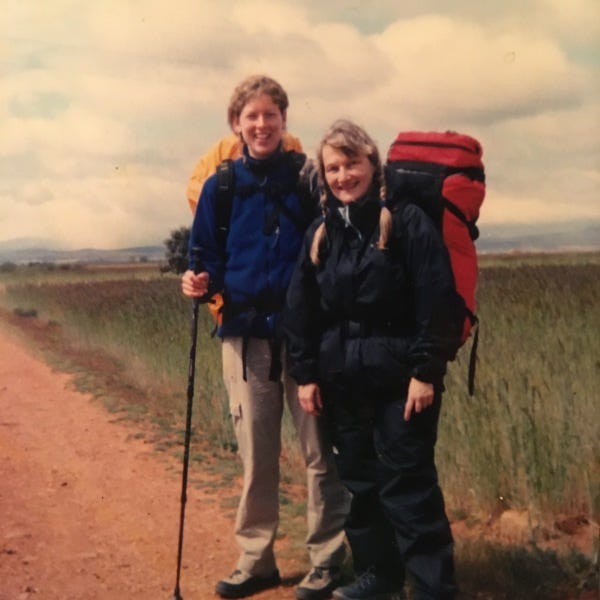
Here is a wonderful radio documentary about walking that my friend Elizabeth made for CBC Radio (Ideas) in 2004. As the blurb for the show explains: “Elizabeth Yeoman presents an ode to the joys of walking. A good, long walk nourishes the mind and heals body and soul. It might even change the world.”
For example, while coming to the finish of a 20 km walk through the countryside, my thighs were burning, my feet pulsed, and I felt a deep sense that walking was “work”. Reflecting that people used to historically travel on foot, it made me connect the word travel with the French word travail=work. We also both noted that walking realigns one’s sense of time to it’s natural set point: the speed of feet. Problems, conflict, low mood etc. seem to resolve or lift naturally in the process of a long walk, reflecting Kirkegaard’s observation, “Health and salvation can be found only in motion... if one just keeps on walking, everything will be all right.”
See Rebecca Solnit’s Wanderlust p.18
A couple of weeks ago we invited readers to contribute pictures of their walks as well as some notes on where, when, and why they walk. We have included many of their reflections as brief vignettes throughout the post. “Thank You!” to everyone who contributed!
https://www.newyorker.com/tech/annals-of-technology/walking-helps-us-think
According to steps-per-day study in the Lancet, "for adults 60 and older, the risk of premature death leveled off at about 6,000-8,000 steps per day, meaning that more steps than that provided no additional benefit for longevity. Adults younger than 60 saw the risk of premature death stabilize at about 8,000-10,000 steps per day."
See Rebecca Solnit’s Wanderlust p. 176
In Praise of Walking: A New Scientific Exploration by Shane O’Mara
See the “Further Listening” section for Elizabeth’s radio documentary on walking for CBC Ideas.
Try to avoid walking indoors, especially malls, where the benefits of walking might be diminished by the overstimulating consumer-focused environment.









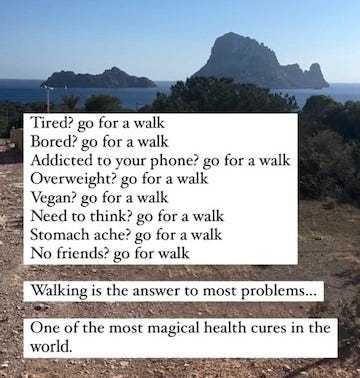



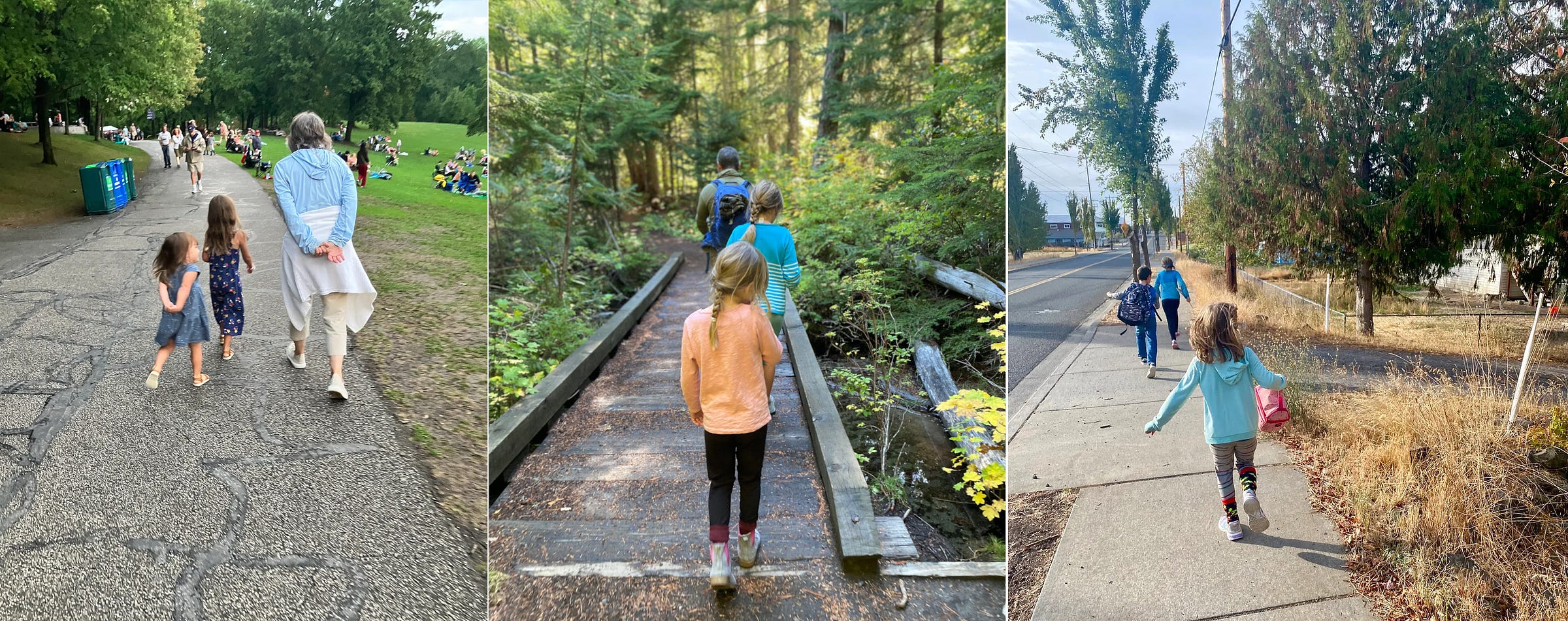
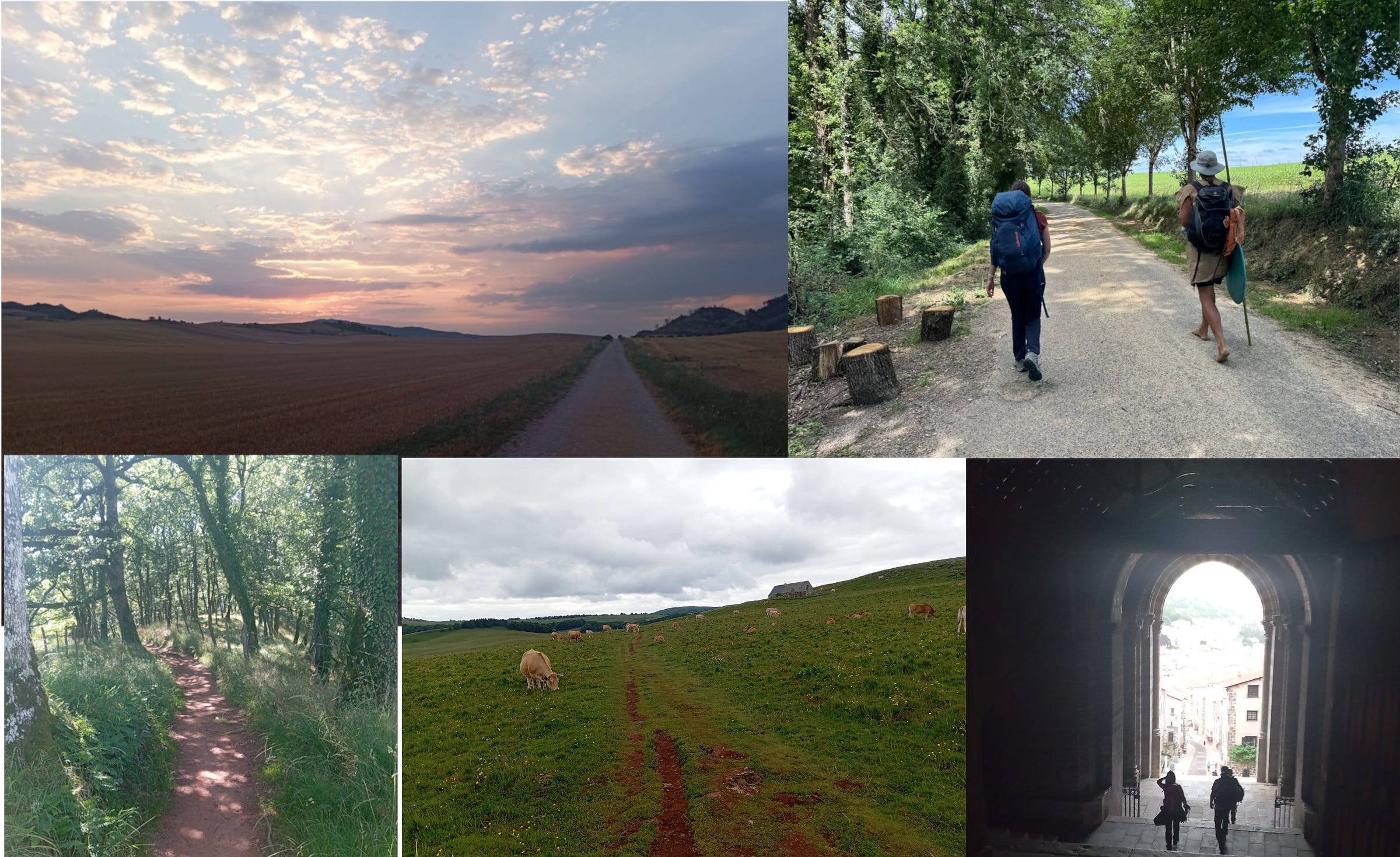
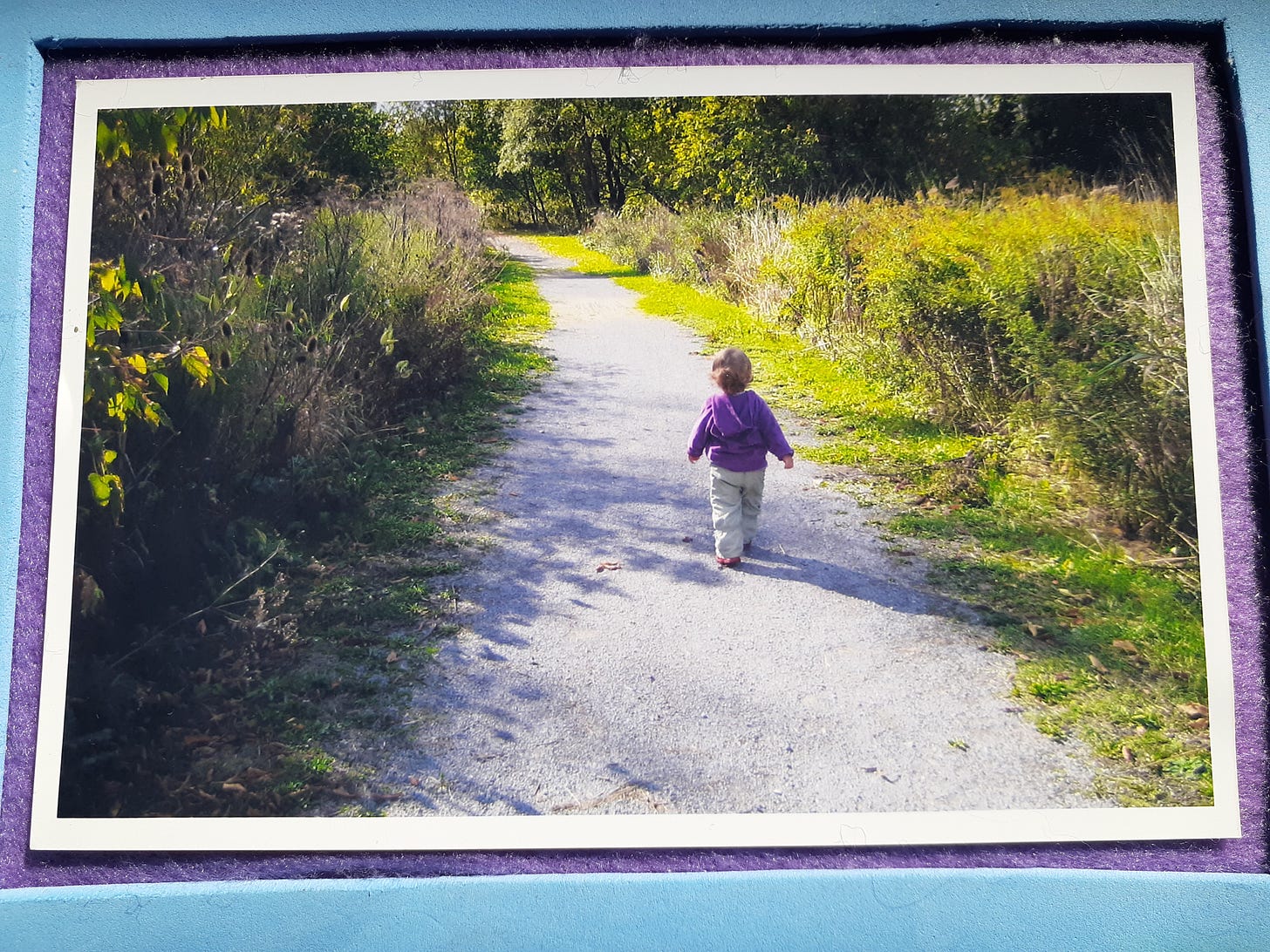


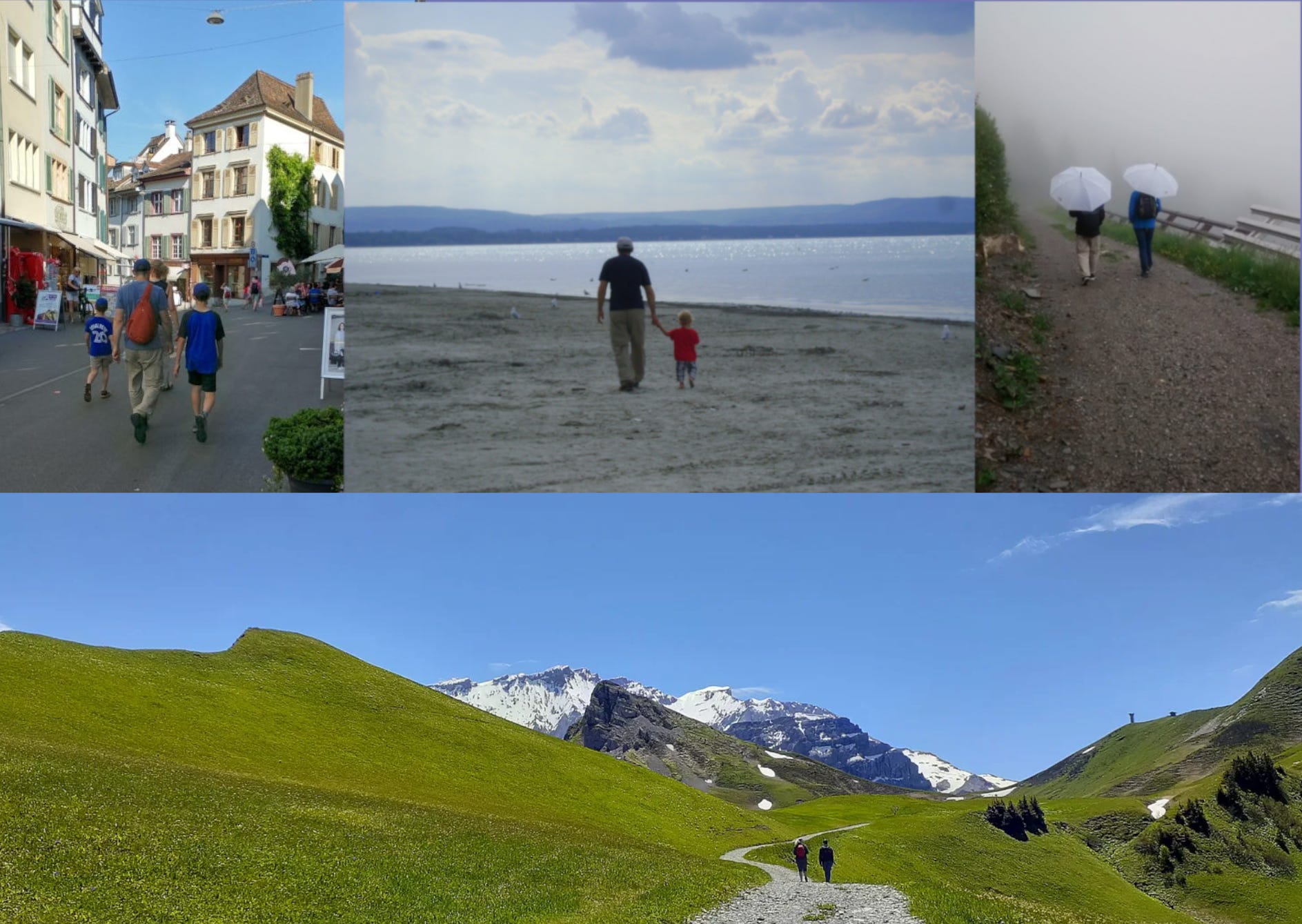

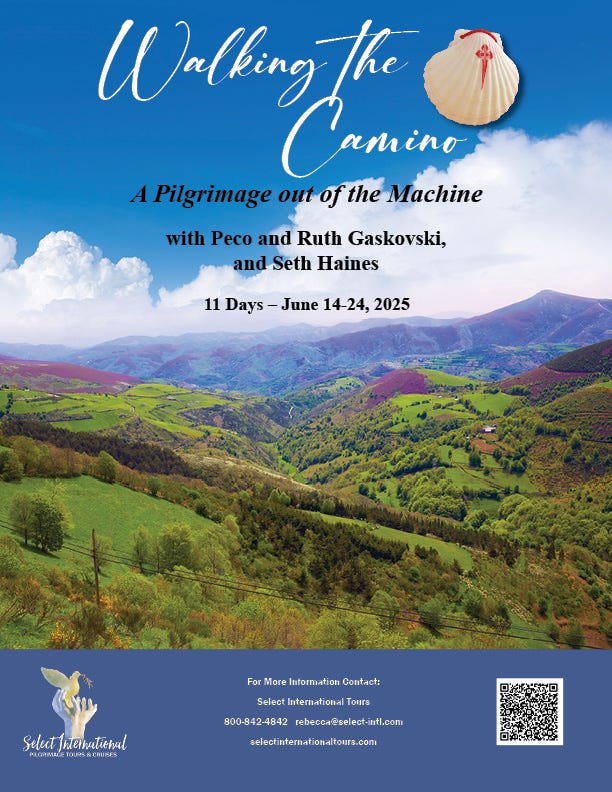
The fractal theory/coherence of mental and physical staten is an incredibly interesting line of thought.
And this is one of my favourite paragraphs I have read on substack:
There might not be any natural remedy in the world as protective as walking against the deadening impact of our sedentary, chair-bound, screen-mesmerized lives. Walking is the original form of scrolling. Yet it doesn’t lead us down online rabbit holes, but past real rabbit holes. It keeps us grounded, literally by keeping our feet on the ground. It keeps us softly fascinated by ever-changing scenery. Walking is calming, head-clearing, and social and even spiritual when we do it together. If walking were a food, it would be a celebrated superfood packed with nutrients that feed our mind, body, relationships, and contact with nature—and it would cost nothing.
-just brilliant Ruth! I keep a common place book of quotes - and this paragraph is going in it in its entirety.
These are the things I *know* and yet our culture of efficiency and convenience (a la the machine) make it so easy to forget.
I read this at the coffeeshop while my youngest did independent work beside me. We had plans to move to the library, about a quarter mile away, once it was time for math. Lately we’ve been driving — but this inspired an EASY “hey bud, we’re going to leave our car here and walk to the library today.”
Along the way we wandered through a piece of civil war history we’ve always seen from the road and never stopped to inspect. It was an absolutely delight, and I’m so thankful for this reminder (and challenge!!).